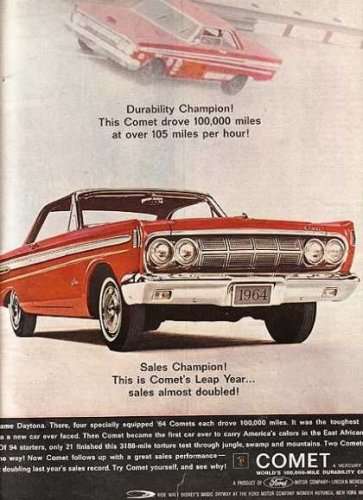Thursday 17th March 1960
The Mercury Comet, the first of the marque to have a 6-cylinder engine, was introduced as a new series.
In late 1958, the Ford Motor Company’s recently consolidated Mercury-Edsel-Lincoln division was struggling to recover from the poor sales numbers that followed the introduction of the unpopular Edsel. Ford had just authorized production of the compact Falcon and the management of MEL, considering the same hunch that the buying public would be interested in a smaller economy car, made an argument for their own compact vehicle. Originally slated to be part of the Edsel line, possibly an effort to bolster Edsel’s sales numbers, the new compact was approved provided it shared the Falcon platform and as much from its parts stock as possible. Known within the company as the Edsel B, the compact shared much of the Falcon’s platform with the exception of having a longer wheelbase and being slightly longer than the Falcon overall. It otherwise would share most of the Falcon’s major components such as the engine, suspension, and basic body shell. In late 1959, the compact, now officially named the Comet, was about to enter production when Ford made the decision to pull the plug on Edsel after the release of the 1960 model year. The Comet project was kept on track, and although it would ultimately be sold through Mercury dealerships, it was initially produced as it’s own model, without the badge of Edsel or Mercury.
The compact Comet was an immediate hit. During the 1960 calendar year, 116,330 Comets were produced. 1960 Comet models included a two-door Sedan, four-door Sedan, and two Station Wagons, available with two doors or four. The Comet was virtually unchanged for 1961 except for exterior trim and the addition of air conditioning as an option. Late in the season, the S-22 Sport Coupe debuted. It was essentially a stylish Comet two-door Sedan with bucket seats and a console. Over 183,000 cars were built.
By 1962, the Comet line expanded to include three trim levels, Comet, Comet Custom, and Comet Special. This year also marked the first time the Comet was officially branded a Mercury. The cat’s-eye taillights were replaced with smaller, round lenses, six on S-22s, and four on lesser Comets.
In 1963, the Comet celebrated its third birthday with the production of its 500,000th car. Comet production for the 1963 model year was 150,694. Power steering was introduced, and the 260 cubic inch V8 engine was offered as an option. 1963 also saw the mid-season introduction of the S-22 two-door Convertible and two-door Hardtop Sportster.
New for 1964, the Caliente replaced the top-of-the-line S-22. The Caliente was available as a four-door Sedan, two-door Hardtop, Convertible, and a Cyclone two-door Hardtop. All Comets featured a Lincoln-inspired grille.
1965 brought impressive style changes in the Comet’s sheet metal. Stacked headlights and angular fenders foreshadowed the 1966 Fairlane design. Model year production dropped to 162,335.
In 1966, the new Capri series replaced the old Comet 404 series. Cyclones and Cyclone GTs were available as two-door Hardtops and Convertibles. Comet calendar year production again dropped, to 153,680.
Changes for 1967 were subtle, however, the Comet received a thorough shakeup for 1968. The only Comet actually available was a two-door Hardtop with a base price of $2,477. The Montego and Montego MX (actually Comet sheet metal with a higher price tag) were only available as two-door Hardtops and four-door Sedans. The Cyclone was no longer available in Convertible form and the Hardtop Coupes were available as Fastbacks or Formal-Roof Hardtops. The 1968 calendar year Comet/Montego production was 149,390.
The 1969 Comet/Montego hotshot of the year was the Cyclone CJ two-door Fastback model with a 428 cubic inch V8 engine. In 1970, the Comet was dropped completely and Montegos took over, offering the Montego MX, Montego Brougham, Cyclone, Cyclone GT, and Cyclone Spoiler models. The Comet name would eventually be brought back in 1971 for the Mercury version of the Ford Maverick.






